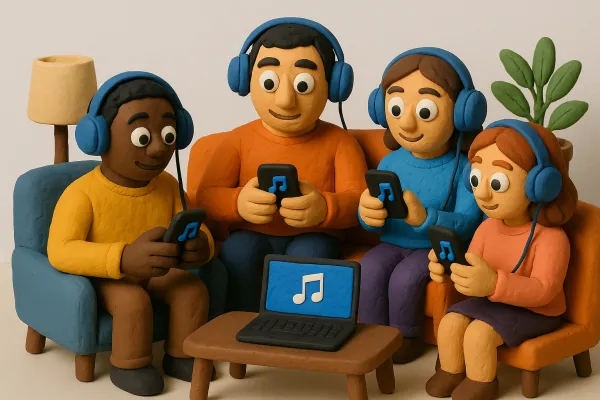Understanding How Much Do Streaming Services Pay: A Comprehensive Breakdown for Artists

In today's music industry, streaming services have become the primary way for people to listen to music. But for artists, the question remains: how much do streaming services pay? Understanding the payout structures of platforms like Spotify, Apple Music, and YouTube is crucial for musicians looking to make a living from their craft. This article breaks down the complexities of streaming payouts, what influences them, and how artists can navigate this evolving landscape to maximize their earnings.
Key Takeaways
- Streaming payouts vary widely between platforms, with Spotify paying around $0.003 to $0.005 per stream, while Apple Music pays more, averaging $0.006 to $0.01.
- Factors like subscription tiers, geography, and user engagement significantly affect how much artists earn from their music.
- Using royalty calculators can help artists estimate their potential earnings based on their stream counts and platform payout rates.
- Emerging artists often struggle to earn a living from streaming, highlighting income disparities in the industry compared to established musicians.
- To maximize revenue, artists should consider distributing their music across multiple platforms and engaging with their audience regularly.
Breaking Down Streaming Payouts
Understanding Per-Stream Rates
Okay, so let's talk about the basics: how much money do you actually get per stream? It's not a simple answer, unfortunately. Different platforms pay different rates, and even those rates can fluctuate. We're talking fractions of a cent here, but it adds up, right? The payout rates are influenced by the artist’s contract with their record label, the listener’s location and subscription type, and the platform itself.
Here's a rough idea of what some platforms pay, but keep in mind these numbers can change:
| Streaming Platform | Average Payout per Stream |
|---|---|
| Tidal | $0.01284 |
| Apple Music | $0.008 |
| Amazon Music | $0.00402 |
| Spotify | $0.00318 |
| YouTube Music | $0.002 |
| Pandora | $0.00133 |
| Deezer | $0.0011 |
Factors Influencing Payouts
So, what makes those per-stream rates jump around? A bunch of stuff, actually. It's not just a flat rate across the board. Here are a few things that can affect your streaming royalties:
- Subscription Type: Premium subscribers usually generate higher payouts than free users because they're directly paying into the system.
- Ad Revenue: For platforms like YouTube, ad revenue plays a big role. More ads, potentially more money for artists.
- Territory: Where your listeners are located matters. Some countries have higher subscription costs and ad rates, which translates to better payouts.
It's a bit of a black box, to be honest. The exact formulas are closely guarded secrets, but these are the main factors at play. Understanding these elements can help you make smarter decisions about where to focus your efforts.
The Role of Subscription Tiers
Subscription tiers are a big deal when it comes to streaming payouts. Think about it: someone paying for a premium subscription is contributing more money to the platform than someone using a free, ad-supported account. That difference trickles down to the artists. Here's the deal:
- Premium Subscriptions: These usually result in higher per-stream payouts because a larger portion of the revenue is directly allocated to royalties.
- Free/Ad-Supported Tiers: These tiers generate less revenue per stream. The platform has to share ad revenue, which is often lower than subscription fees.
- Bundled Subscriptions: Some services offer music streaming as part of a larger bundle (think phone plans or other services). The payout rates for these can vary widely depending on the specific agreement.
How Much Do Streaming Services Pay Artists?
We all know streaming is how most people listen to music now. It's just so easy and convenient. But how much do artists actually make from these platforms? It's a question a lot of us in the music world are constantly asking.
Spotify's Payment Structure
Spotify's payment system can feel like a big mystery. Basically, artists get a tiny fraction of a cent for each stream. The exact amount changes based on a bunch of things, like Spotify's overall revenue, the artist's specific deal, and even what kind of subscription the listener has. It's not a ton of money per stream, and you need millions of streams to really make a living. To distribute your music effectively, understanding these nuances is key.
Apple Music's Competitive Edge
Apple Music is often seen as a bit more artist-friendly. They tend to pay a higher rate per stream compared to some other platforms.
Apple Music has said they want to support artists and give them fair pay. While the exact numbers can change, they generally offer a better payout, which makes them a favorite for many musicians. But remember, it still depends on your record deal and where your listeners are located.
YouTube's Unique Model
YouTube is a whole different ballgame. It's not just about music; it's a video platform, so payments are tied to ad revenue. This means the amount artists earn per stream can vary quite a bit. It's generally lower than Spotify or Apple Music, but the potential audience is huge. Here's a quick breakdown:
- Ad revenue sharing
- Variable rates
- Vast audience reach
While the per-stream rate might be lower, the sheer volume of potential views can add up. Plus, YouTube offers other ways to make money, like channel memberships and merchandise shelves. It's all about finding the right balance and pay artists bonuses to keep them motivated.
Calculating Your Streaming Royalties
Using Royalty Calculators
Okay, so figuring out how much you're actually making from streaming can feel like trying to solve a puzzle with missing pieces. But don't worry, we're here to help break it down. There are tools out there that can make this way easier. Think of them as your financial sidekick in the music world.
- Online calculators are your friend. Seriously, these things are designed to take the headache out of royalty calculations. You just plug in some numbers, and boom, you get an estimate.
- They often let you specify the platform (Spotify, Apple Music, etc.) because each one pays differently. It's not a one-size-fits-all situation.
- Keep in mind that these are estimates. The actual amount you get might vary a bit, but it's a good starting point.
It's important to remember that these calculators are based on averages. Your actual payout could be higher or lower depending on a bunch of factors, like where your listeners are located and whether they have premium subscriptions.
There are many options, such as a Spotify revenue calculator, that can help you get a better understanding of your potential income.
Estimating Earnings Per Stream
Let's talk about the nitty-gritty: how much you make per stream. This is the foundation of understanding your royalties. The amount you earn per stream varies quite a bit depending on the platform.
Here's a super simplified example:
| Platform | Average Payout per Stream | Example Earnings (100,000 Streams) |
|---|---|---|
| Spotify | $0.003 - $0.005 | $300 - $500 |
| Apple Music | $0.006 - $0.01 | $600 - $1000 |
| YouTube Music | $0.0006 - $0.00139 | $60 - $139 |
To get a rough estimate, you can use this formula:
Royalties = (Number of Streams) x (Average Payout Rate)
So, if you have 100,000 streams on a platform that pays $0.004 per stream, you'd estimate your royalties at $400.
Real-Life Examples of Earnings
Okay, let's make this real with some examples. Imagine you've got a track that's doing pretty well. Let's say it hits 1 million streams across different platforms. How does that translate into actual money?
Let's break it down:
- Spotify: 500,000 streams x $0.004 = $2,000
- Apple Music: 300,000 streams x $0.007 = $2,100
- YouTube Music: 200,000 streams x $0.0008 = $160
In this scenario, you'd be looking at a total of $4,260. Not bad, right? But remember, this is just an example. Your actual earnings will depend on a bunch of things, including your music distribution agreements and listener demographics.
The Impact of Geography on Royalties
Regional Variations in Payouts
Streaming payouts aren't the same everywhere. What you earn in one country can be very different from what you earn in another. This is because things like subscription prices, ad revenue, and how much people use streaming services vary from place to place. For example, streams from countries with lower ad revenue might yield less than those from countries where people pay more for subscriptions. It's a global game, but the rules change depending on where your listeners are.
How Country Affects Earnings
Where your listeners are located has a big impact on your royalties. Different countries have different economies and different levels of engagement with streaming services. This means that the amount you earn per stream can change a lot depending on the region. For example, a stream in the US or Europe, where subscription rates are higher, will typically pay more than a stream in a country with lower average income. It's all about the economics of the region.
Here's a simplified example:
| Country | Avg. Payout per Stream |
|---|---|
| USA | $0.004 |
| Mexico | $0.002 |
| India | $0.001 |
Understanding Global Markets
To really make the most of streaming, we need to understand global markets. This means looking at where our music is popular and tailoring our approach to those regions. Are we big in Brazil? Maybe we should focus on marketing there. Do we have a lot of listeners in Germany? Let's see what we can do to engage them even more. Understanding these markets helps us make smarter decisions about where to focus our efforts. For example, music royalties in Nigeria have significantly impacted artists' earnings, demonstrating the importance of geographic location.
It's important to remember that streaming is a global platform. Understanding the nuances of different markets can help us maximize our earnings and reach a wider audience. By paying attention to where our listeners are and tailoring our approach accordingly, we can make the most of the opportunities that streaming offers.
Here are some things to consider:
- Local Popularity: Where is our music most popular?
- Marketing Efforts: Are we targeting the right regions?
- Cultural Differences: Are we aware of cultural nuances that might affect our music's reception?
Navigating the Streaming Landscape
It's a jungle out there, right? So many platforms, so many options. How do we, as artists, even begin to figure out where to focus our energy? It can feel overwhelming, but with a little strategy, we can make smart choices about where to put our music.
Choosing the Right Platforms
Not all streaming services are created equal. Some might have a bigger audience in a specific genre, while others might offer better royalty rates (though, let's be real, those rates are still pretty low). We need to think about who we're trying to reach and where those people are already listening. Are we targeting a younger crowd that lives on TikTok and YouTube? Or are we aiming for a more mature audience that prefers Spotify or Apple Music? Understanding our target demographic is key. Also, consider the music streaming payouts comparison to see which platform offers the best rates.
Maximizing Your Exposure
Okay, so we've picked our platforms. Now what? We can't just upload our music and hope for the best. We need to actively work to get our music heard. This means optimizing our profiles, using high-quality artwork, and writing compelling descriptions. Think of our artist profile as our online storefront – we want to make it as appealing as possible.
Here are a few things we can do:
- Engage with fans in the comments section.
- Create playlists featuring our music and the music of other artists we admire.
- Submit our music to relevant playlists curated by the platform or other users.
It's not enough to just be on the platforms; we need to be active on them. That means consistently posting, engaging with our fans, and looking for opportunities to collaborate with other artists. Think of it as building a community, not just promoting our music.
Engaging Your Audience Effectively
Building a fanbase is more than just getting streams; it's about creating a connection. We need to give our fans a reason to care about our music and about us as artists. This could mean sharing behind-the-scenes content, interacting with them on social media, or even just responding to their comments and messages. Let's not forget the importance of strategic streaming promotion to reach a broader audience.
Here are some ideas:
- Run contests and giveaways to get people excited about our music.
- Ask our fans for feedback on our songs or upcoming projects.
- Share our personal stories and experiences to create a deeper connection.
The Future of Streaming Royalties
Trends in Artist Compensation
Okay, so where are things headed? We're seeing some interesting shifts. More artists are pushing for fairer deals and greater transparency. It's not just about the big names either; indie artists are finding ways to band together and make their voices heard. We're also seeing a rise in alternative compensation models, which is pretty cool.
- Direct artist payments from platforms
- Fan-funded projects becoming more common
- Blockchain tech potentially changing how royalties are tracked and distributed
Potential Changes in Payout Models
Let's be real, the current payout system isn't perfect. There's talk about moving away from per-stream rates to something that values engagement more. Maybe weighting streams based on listener location or subscription type? Or even exploring a user-centric model where royalties are tied to individual listening habits. It's all up in the air, but change is definitely brewing. Understanding streaming royalties is more important than ever.
The Role of Emerging Platforms
New platforms are popping up all the time, each trying to do things a little differently. Some are focusing on niche genres, others on direct fan interaction. These emerging platforms could shake up the industry by offering artists better deals or more control over their music. It's exciting to see what the future holds, and how these platforms will impact artist compensation.
It's clear that the conversation around streaming royalties is far from over. As technology evolves and artists become more vocal, we can expect to see continued experimentation and innovation in how musicians are compensated for their work. The goal is to create a system that's fair, transparent, and sustainable for everyone involved.
As we look ahead, the way artists earn money from streaming is changing fast. New ideas and technologies are coming up that could make things fairer for everyone involved. If you want to learn more about how these changes might affect your favorite musicians and the industry, check out our website for the latest updates and insights!
Wrapping It Up
So, there you have it! Streaming services can be a bit of a mixed bag for artists. On one hand, they offer a way to reach tons of listeners, but on the other, the pay per stream can feel pretty disheartening. If you’re an artist, it’s super important to know how these payouts work and to keep an eye on your earnings. Don’t just put all your eggs in one basket—think about other ways to make money, like gigs or merch. And remember, every stream counts, but you might need a whole lot of them to really see the cash flow. Stay savvy out there!
Frequently Asked Questions
How much money do artists make for each stream?
Artists typically earn between $0.003 and $0.005 per stream on Spotify. Apple Music pays a bit more, around $0.006 to $0.01, while YouTube pays less, usually between $0.00067 and $0.00139.
What factors determine how streaming royalties are calculated?
Royalties are calculated based on the number of streams and the average payout rate for each platform. This means different platforms pay different amounts for each stream.
How can I estimate my royalties from streaming?
You can use a royalty calculator. Just enter your total streams, and it will give you an estimate of how much you could earn from each platform.
Do streaming payouts vary by country?
Yes, payouts can be different depending on the country. Factors like subscription prices and advertising revenue can change how much artists make.
What is the best way for artists to earn more from streaming?
To earn more, artists should distribute their music on multiple platforms, engage with their fans, and try to get their songs on popular playlists.
What is the future of streaming royalties for artists?
The future might bring changes in how artists are paid, with new platforms and trends emerging that could affect payouts and artist compensation.





